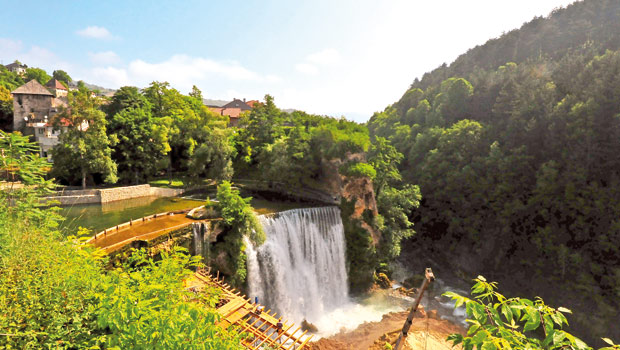Jajce is a small town with a population of just 30,000 located in central Bosnia. Despite the rural feel it casts, this town has a lot to offer its visitors. The highlight of the visit is the waterfall, an impressive 21-meter waterfall literally in the middle of the town. Jajce also plays host to a couple of ancient buildings like the 15th century St. Luke Tower and the ancient fortress around which the old town is built. Another prominent Jajce attraction is the catacombs. Dating back to the 1400s, the underground burials are distinctive with sun and moon engravings, a trademark sign of the medieval quasi-independent Church of Bosnia.
Not far from Jajce are the serene Pliva Lakes. Nestled amid wooded hills, the two lakes make up for an amazing spot to spend a relaxing weekend. Nonetheless, if you are short on time, you can still head there to get a glimpse of the watermills. Seventeen old wooden miniature structures, Pliva Lakes’ watermills use the water current to grind seeds. It was a quite a helpful tool long before electricity was invented. The watermills add a touch of beauty to the postcard-perfect Pliva Lakes, huddled amid the water streams and lush green surroundings.
At the other end of the Bosnia and Herzegovina tourism spectrum lies Mostar. To the contrary of Jajce, which is hardly featured on tourists’ brochures, Mostar is the country’s tourism prima donna.
In the local tongue, Mostar means the “bridge keeper,” and it doesn’t come as a surprise that the epicenter of Mostar’s tourism industry is the Old Bridge, or rather Stari Most as it is locally known. Working on the bridge took off in 1557 when the famous Ottoman sultan Suleyman the Magnificent ordered the building of a stone bridge to replace an already existing suspended one. Suleyman saw a golden opportunity in building a bridge across the turbulent and cold Neretva River, and indeed he was right. In no time, Mostar flourished, courtesy of the trade that passed through its bridge.
Mostar suffered gravely during the Balkan War as Bosnian Muslims (Bosniaks) and Bosnian Croats exchanged artillery salvo across the banks of the Neretva River. Everyone and everything in Mostar was impacted by the war. Not only military establishments, or even civilian buildings, were impacted, but also religious ones. All of Mostar’s 27 Ottoman era mosques were blistered and ruined. The biggest blow, however, came in November 1993 when, after standing for 427 years, Stari Most collapsed. It was fired at 64 times by Bosnian Croat forces. The moment Stari Most fell has left an eternal mark on each and every Mostar resident, regardless of which side of the conflict he/she once belonged. After the guns were silenced and the war came to an end, international efforts poured in rebuilding most of Mostar’s UNESCO-listed Old City. By 2004, Stari Most was rebuilt following the same old techniques and using more or less the same materials.
Another interesting stop on my Bosnia and Herzegovina interlude was Blagaj. A stone’s throw away from Mostar, Blagaj is a small village that hosts an ancient fortress and an old dervish house. Occupying a hilltop, the ancient fortress comes in with an impressive posture and, of course, a painstaking climb. The fort belongs to Herceg Stjepan after whom the whole region is named: Herzegovina. The old dervish house, or rather tekiah (tekija in the local tongue) as it is mostly referred to, was built clinging to soaring cliffs at a cave mouth and right by the waterfront. Its picturesque scene leaves you in awe. It is said that this old wooden tekiah is the resting place of two 15th century Tajik dervishes.
Remnants of war are slowly diminishing to memories as the bullet-riddled building and fallen down bridges are being renovated and rebuilt. Tourism in Bosnia and Herzegovina might still be in its infancy, but with super scenic views and multicultural heritage, it has great potential for growth in Europe’s undiscovered Eden.
Turkish Airlines has several flights a day connecting Bosnia and Herzegovina’s capital Sarajevo to Istanbul and onward to other destinations in the Middle East.
In Jajce, staying at Hotel Stari Grad is a must. After all, how many hotels in the world come with a glass floor in their restaurants under which are ruins of an Ottoman era hamam.
hotel.satri.grad@tel.net.ba
+378 (30) 654 006
Mostar’s Old City is peppered with various accommodation options, but if you are looking for something different, then perhaps you would not mind stepping outside the Old City area and give Muslibegovic House a try. A restored 18th century old Ottoman house turned museum turned homestay hotel, Muslibegovic House offers its residents the unique opportunity to sleep in a museum.
www.muslibegovichouse.com
+387 (36) 551379










